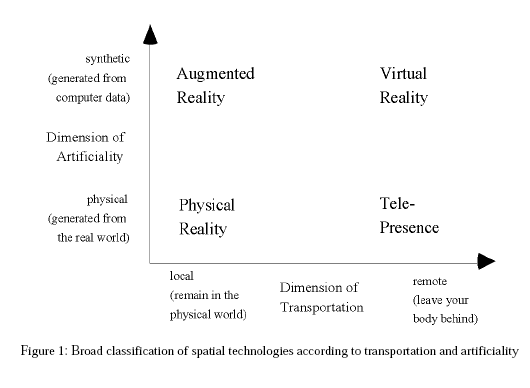Shared space
Definition
- Shared spaces are an important concept and design variable in CSCW Virtual environments and ubiquitous computing research.
- Shared space technologies aim to create distributed electronic environments where participants can exploit spatial properties such as containment and movement in order to manage their communication (Benford et al. 1998).
Types
The Benford taxonomy
Benford et al. define three dimensions that characterize shared spaces:
- (1) Transportation
... the extent to which a group of participants and objects leave behind their local space and enter into some new remote space in order to meet with others, versus the extent to which they remain in their local space and the remote participants and objects are brought to them. One one side of this range we find physical face-to-face meetings and on the other immersive virtual reality and immersive telepresence applications.
This transportation concept is similar to the VR immersion concept. “However transportation allows the possibility of introducing remote participants and objects into the local environment that then becomes augmented rather than excluded. [...] Second, transportation considers how groups of participants and possibly other objects such as physical documents might be transported together.” (Benford, 1998:191)
- (2) Artificiality
... the extent to which a space is either synthetic or is based on the physical world. This spans the extremes from wholly physical to wholly synthetic environments. On one side we have telepresence applications (like videoconferencing) and on the other side CVEs that model participants and objects (visualizations, arts, etc.) with abstract data.
Artificiality and transportation allows to categorize various categories of shared spaces.

- (3) Spatiality
... their level of support for fundamental physical spatial properties such as containment, topology, distance, orientation, and movement. On on end we find shared spacial frames (e.g. physical meetings or high-end telepresence systems. On the other end is telephone confencing and chat (no spatial containment).
The Milgram Kishino taxonomy
According to Benford (1998b), Milgram and Kishino (1994) taxonomy includes three dimensions:
- Extent of world knowledge - the degree to which the computer system knows about which objects are in a given physical space and where they are (i.e., the extent to which the physical space can be modelled within the computer);
- Reproduction fidelity - the level of image quality of either the real or virtual world;
- Extent of presence metaphor - the extent to which an observer is intended to feel present within the scene.
- to do
See also ubiquitous learning
References
- Benford, S., Greenhalgh, C., Reynard, G., Brown, C., and Koleva, B. (1998). Understanding and constructing shared spaces with mixed-reality boundaries. ACM Trans. Comput.-Hum. Interact. 5, 3 (Sep. 1998), 185-223. Abstract/PDF (Access restricted)
- Benford, Steve and Chris Greenhalgh and Chris Brown and Boriana Koleva (1998b). Understanding and Constructing Shared Spaces with Mixed Reality Boundaries. TOCHI Paper, March 13 1998 PDF
- Hall T., Ciolfi L., Bannon L.J., Fraser M., Benford S., Bowers J., Greenhalgh C., Hellström S-O., Izadi S., Schnädelbach H. and M. Flintham, "The Visitor as Virtual Archaeologist: Explorations in Mixed Reality Technology to Enhance Educational and Social Interaction in the Museum". Proceedings of VAST 2001, Conference on Virtual Reality, Archaeology and Cultural Heritage, November 28-30, 2001, Glyfada, Greece: ACM Press, 2001, 91-96. PDF
- Milgram, P. and Kishino, F., A Taxonomy of Mixed Reality Visual Displays, IEICE Transactions on Information Systems, Vol E77-D, No 12, December 1994.
- Nova, Nicolas, Socio-cognitive functions of space in collaborative settings: a literature review about Space, Cognition and Collaboration, CRAFT Research Report, EPFL. PDF